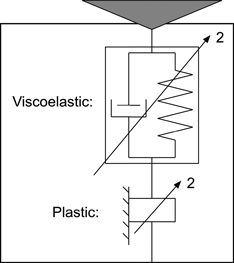Published online by Cambridge University Press: 15 March 2018

The time-dependent pyramidal or conical indentation of viscoelastic–plastic materials, such as glassy polymers, is examined by a flexible, Kelvin-like model. The model equation is simply solved numerically for a wide range of material properties and indentation loading sequences. The flexibility of the model is demonstrated by generating typical indentation responses for a metal, a ceramic, an elastomer, and a glassy polymer. Polymer indentation is further examined under ramp, hold, and cyclic loading conditions, including adhesive effects. The model and approach should be particularly useful in identifying the various deformation components contributing to observed instrumented indentation phenomena.